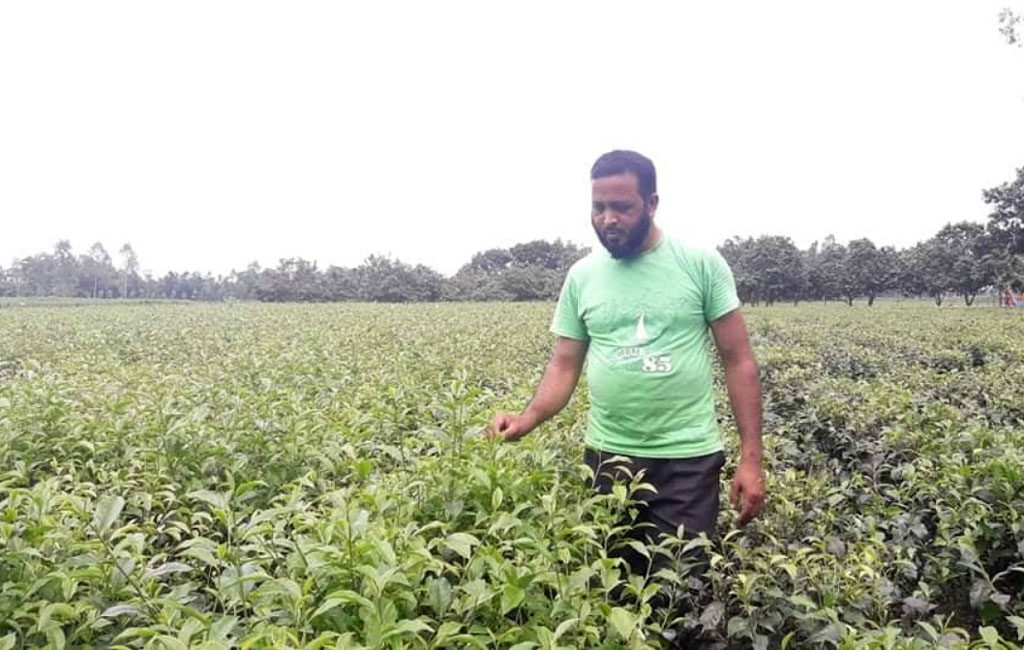Dinajpur tea! : Pioneering farmer brings tea gardens to unlikely district
Inspired by the well-established lowland tea plantation in neighboring Panchagarh and in some parts of Thakurgaon district, Nazrul Islam from Jhaljhali village in Dinajpur’s Birganj upazila has been trying his hand at cultivating tea.
In August last year, the 36-year-old planted 6,000 tea saplings on two acres, and six months later leaves were plucked for the first time making up the initial harvest of almost 50 kilograms. He had bought those saplings from a nursery in Panchagarh at Tk 4 each.
The volume of suitable leaves produced by the plants has been steadily increasing. At the beginning of this month Nazrul harvested nearly 500 kilograms of leaves, he says.
In total, he has collected nearly 1,000 kilograms of leaves from his tea garden.
Nazrul sells leaves to North Bengal Tea Factory in Panchagarh for Tk 25 per kilogram.
With encouraging results from his ground-breaking endeavor, the farmer is already thinking of expanding his tea plantation.
Even without expansion, he estimates that after two years, as the tea bushes will be more mature, he will earn Tk 25,000 per month, which he earned this year, by selling tea leaves.
Bangladesh’s burgeoning tea industry dates back to the British colonial period when large scale tea plantation was introduced in Sylhet and Chittagong. Till 2000, all tea estates were in greater Sylhet and in the districts of Brahmanbaria, Chittagong and Rangamati.
However, considering the geographical proximity of Panchagarh’s Tentulia to India’s tea growing region of Darjeeling, some companies started small-scale tea plantation in the northwest tip in 2000, and eventually it expanded to neighboring Thakurgaon district.
Seeing the tea potential unlocked in his part of the country, Nazrul went for tea venture in Dinajpur.
He says that tea bushes grow with little effort. “In the last year I have applied organic fertilizer twice. Apart from that, the garden need only be watered regularly.”
Nazrul has planted neem trees at intervals to protect the tea bushes from direct sunlight.
“Nazrul Islam is the pioneer tea grower in Dinajpur district,” says Mostafizur Rahman, an official of the agriculture extension department in Birganj.
“Tea has bright prospects here as the local geography and climate are favorable, especially because it is not too far from the Himalayas.”
Mostafizur believes the area’s rural economy can be transformed by tea cultivation.
Indeed Nazrul’s efforts have already inspired many. Azad Ali, a farmer from nearby Paltapur Ashrayan village, is enthusiastically following in his footsteps.
Azad planted tea saplings on two acres in early February this year.
“Initially, I planted 3,500 tea saplings on my land, hearing about Nazrul’s success. I have spoken with the department of agriculture extension officials in Birganj and am now determined to convert my paddy land into a tea garden.”
Thus far, Azad has harvested 300 kilograms of leaves.
Dinajpur’s farmers have proved themselves adaptable in recent years, achieving success with several new crops including oranges, maltas and dragon fruits. Nowadays, with many other local farmers considering the merits of Nazrul’s tea cultivation, it looks as though tea production has the potential to become the district’s newest agricultural success.









